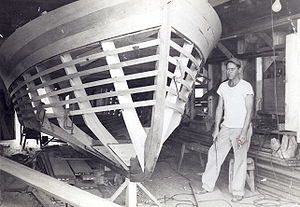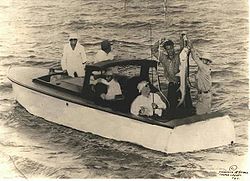
Farley Boats
Encyclopedia

History of the Farley Boat

Tarpon
Tarpons are large fish of the genus Megalops. There are two species of Megalops, one native to the Atlantic, and the other to the Indo-Pacific oceans.They are the only members of the family Megalopidae.- Species and habitats :...
fishing had begun to attract anglers from all across America to Port Aransas, Texas
Texas
Texas is the second largest U.S. state by both area and population, and the largest state by area in the contiguous United States.The name, based on the Caddo word "Tejas" meaning "friends" or "allies", was applied by the Spanish to the Caddo themselves and to the region of their settlement in...
. However, because of the choppy waters, access to the Gulf Coast was severely restricted. The boats of the day were not designed or built to handle the rough Gulf Coast waters and storms in the early 1900s wiped out the existing charter fleet. The local guides and fishermen were desperate for boats.
Charles Frederick ("Fred") Farley, a master craftsman, was living in Birmingham, Alabama
Birmingham, Alabama
Birmingham is the largest city in Alabama. The city is the county seat of Jefferson County. According to the 2010 United States Census, Birmingham had a population of 212,237. The Birmingham-Hoover Metropolitan Area, in estimate by the U.S...
, when he learned from his brother that the guides of Port Aransas needed boats to satisfy the great demand for tarpon
Tarpon
Tarpons are large fish of the genus Megalops. There are two species of Megalops, one native to the Atlantic, and the other to the Indo-Pacific oceans.They are the only members of the family Megalopidae.- Species and habitats :...
fishing. Fred traveled to the Gulf Coast with his three brothers where they designed and built utility boats, lighthouses, and ornate bars. Eventually, Fred settled down in Port Aransas, Texas, with his son and began designing and building boats. They established Farley and Son, Boat Builders, in 1915.
Fred's earliest fishing boat design was an 18-footer built to meet the needs of local fishing guides. It was designed with low-sides and a high bow
Bow (ship)
The bow is a nautical term that refers to the forward part of the hull of a ship or boat, the point that is most forward when the vessel is underway. Both of the adjectives fore and forward mean towards the bow...
to fight the choppy waves. At that time, the only boats available to local angles and guides were flat bottomed with high sides so they were not well equipped for the Gulf Coast chop. The Farley boat, on the other hand, was designed to fish the local waters and could handle the choppy water.
The earliest Farley Boats were 18 to 22 footers that carried two people. Later, the Farleys designed and built larger boats to accommodate more people and larger engines. The Farley Boats were known for a high chine
Chine
A chine is a steep-sided river valley where the river flows through coastal cliffs to the sea. Typically these are soft eroding cliffs such as sandstone or clays. The word chine originates from the Saxon "Cinan" meaning a gap or yawn....
didn't touch the water until well aft of the bow and a hatch in front of the windshield that opened. The Farley Boats were also designed with low cabins that allowed fishing in every direction.
Originally, Farley Boats were built with 5/8 in planks of top-grade cypress. They were light and very durable. After World War II, cypress became scarce and the Farley's switched to Honduran and Philippine mahogany.

Fred Farley's sons, Fred Farley Jr. and Jim Farley grew up building boats with their father and continued with the family business after Fred's death. After World War II, the boat works was moved to Mercer Street in Port Aransas, where it remained until around 1968 then moved to Ave.C. The Farley family designed and built Farley Boats until 1975.
Farley Boats were high quality boats and built to last. However, because of hurricanes, there are very few remaining Farley Boats. Historians, anglers and boat builders are always on the lookout for Farley Boats.
FDR and the Farley Boat

Judiciary Reorganization Bill of 1937
The Judicial Procedures Reform Bill of 1937, frequently called the court-packing plan, was a legislative initiative proposed by U.S. President Franklin Roosevelt to add more justices to the U.S. Supreme Court. Roosevelt's purpose was to obtain favorable rulings regarding New Deal legislation that...
, he traveled to Port Aransas specifically to catch tarpon. He hired Barney Farley, the famous fishing guide and brother of Fred Farley.
The president brought his own 35-foot fishing boat and Barney Farley agreed to take the President out on the boat. After an unsuccessful outing, Barney Farley convinced the president to fish from a Farley Boat. The President caught so many tarpon that he returned to Port Aransas later that year to again fish with Barney Farley on a Farley Boat.

